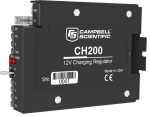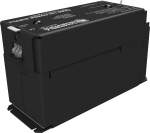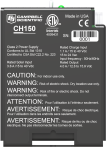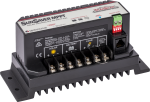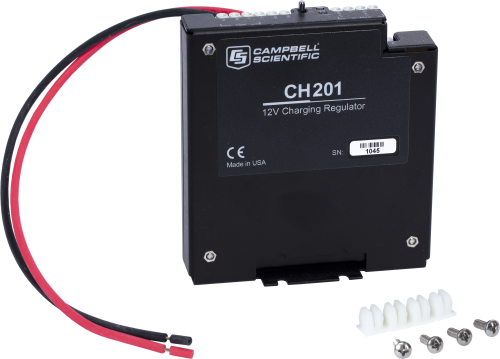
Ideal for extreme latitudes and high-power devices






Overview
The CH201 is a microcontroller-based smart charge controller that is ideal for charging 12 Vdc VRLA batteries. The charger uses MPPT (maximum power point tracking) technology to safely manage amperage and voltage for optimal battery charging and longevity. It has dual inputs for use with a solar panel and/or any 15 to 50 Vdc charging source. The dual inputs provide the option for fail-safe charging. The CH201 also outputs various parameters to allow close monitoring of the battery and power usage via RS-232 or SDI-12.
In your system, use the CH201 to charge your battery and supply power to your peripherals and data logger. The 12 V output is regulated and switched, with the ability to charge a 12 V battery at a rate of 10 A.
Read MoreBenefits and Features
- Dual inputs for simultaneous charging, allowing a fail-safe if one source drops out
- Real-time measurements of charging source voltages, battery voltage, battery charging current, load current, charge state, and on-board temperature, plus a check-battery flag
- Efficient continuously adaptive MPPT (maximum power point tracking)
- Two-step constant voltage charging and temperature compensation to optimize battery charging and increase battery life
- Reverse battery protection
- Programmable LVD (low-voltage disconnect) to protect batteries
- DevConfig user interface to change system parameters or install a new OS
- Two 15 to 50 Vdc inputs to accommodate multiple solar panels
- Synchronous rectification in the switching regulator for increased DC/DC conversion efficiency
- Individually programmable current limits on both of two inputs
- Solid-state circuit breaker for automatic reset and more precise trip current
- DC-to-DC converter with built-in output current control
- Serial communication wiring through three terminals
Technical Description
The CH201 provides 10 A of charge current, making it ideal for systems with short periods of sun, or higher-current draw systems that require higher recharge rates. The CH201 has two input terminals that enable fail safe charging should one source drop out. It also incorporates an MPPT (maximum power point tracking) algorithm to maximize available solar. The CH201 has a programmable, low-voltage disconnect to help protect the battery. RS-232 and SDI-12 terminals allow the CH201 to be configured and to convey charging parameters to a data logger.
Compared to the CH200, the CH201 offers faster charging with the use of larger solar panels, up to 160 W. (Larger solar panels can be connected; however, when the system is running at full power, not all the current will be used.)
Compared to the SunSaver SS-10-12V, the CH201 offers:
- Dual inputs
- Current monitoring via RS-232 and SDI-12
- Configurability
- Low-voltage disconnect (The SunSaver SS-10-12VL has LVD.)
- Low current drain
Images














Compatibility
Please note: The following shows notable compatibility information. It is not a comprehensive list of all compatible products.
Additional Compatibility Information
Data Loggers
The CH201 is compatible with SDI-12 data loggers for communications. The CH201 could power any data logger with 12 V.
Specifications
| Operational Temperature | -40° to +60°C (VRLA battery manufacturers state that “heat kills batteries” and recommend operating batteries at less than 50°C.) |
| IP Rating | IP51 |
| Dimensions | 11.4 x 10.08 x 3.38 cm (4.49 x 3.97 x 1.33 in.) |
| Weight | 226.8 g (0.5 lb) |
SOLAR Terminals (Solar Panel or Other DC Source) |
|
| -NOTE- | Battery voltages below 8.7 V may result in less than 3.0 A current limit because of fold-back current limit. |
| Input Voltage Range | 15 to 50 Vdc |
| Maximum Output Current | 12 A |
| Rated Input Current | 12 A |
Battery Charging |
|
| -NOTE- | Two-step temperature-compensated constant-voltage charging for valve-regulated lead-acid batteries; cycle and float charging voltage parameters are programmable with the default values listed. |
| Maximum Charging Current | 10 A |
| CYCLE Charging | Vbatt(T) = 14.70 V - (24 mV) x (T-25°C) |
| FLOAT Charging | Vbatt(T) = 13.65 V - (18 mV) x (T-25°C) |
Quiescent Current |
|
| No Charge Source Present | 300 µA maximum |
| No Battery Connected | Typical 5 mA at 40 Vdc |
Power Out (+12 Terminals) |
|
| Voltage |
|
| LVD (Low-Voltage Disconnect) | 6 Vdc (default) |
Measurements |
|
| Input Voltage | ±(1% of reading + 15 mV) |
| Battery Voltage | ±(2% of reading + 15 mV) |
| Load Current |
±(2% of reading + 2 mA) Impulse-type changes in current may have an average current error of ±(10% of reading + 2 mA). |
| Battery Current |
±(2% of reading + 10 mA) Impulse-type changes in current may have an average current error of ±(10% of reading + 2 mA). |
| Charger Temperature | ± 2°C |
Resources and Links
Product Brochures
Manuals
Compliance
Downloads
CH201 Example Programs v.2 (3 KB) 11-01-2022
Two CR1000X data logger programs that monitor the CH201. One example program uses RS-232, and the other example program uses SDI-12 communications.
CH201 OS v.3.0 (431 KB) 29-03-2024
Execution of this download installs the CH201 Operating System on your computer.
Note: The Device Configuration Utility is used to upload the included operating system to the CH201.
Listed Under
FAQs for
Number of FAQs related to CH201: 3
Expand AllCollapse All
-
The CH201 uses the input with the highest voltage.
-
- The CH201 can monitor incoming and outgoing currents, battery voltage, and temperature.
- The CH201 uses MPPT (maximum power point tracking) technology, which is much more efficient and prolongs battery life compared with the 18529's PWM (pulse width modulated) method.
- The 12 Vdc output terminals of the CH201 (or load terminals) are limited to 4.65 A current, whereas the 18529's terminals are not.
- The CH201 has an LVD (low voltage disconnect) that is set by the user to save battery life, but the 18529 does not have an LVD.
-
The total that the CH201 can handle is 12 A. However, unless the two inputs have exactly the same voltage, only one source will be used. Therefore, technically, both sources can be 12 A each, assuming that they will not operate at the same voltage and trip the thermal fuse.
Privacy Policy Update
We've updated our privacy policy. Learn More
Cookie Consent
Update your cookie preferences. Update Cookie Preferences

